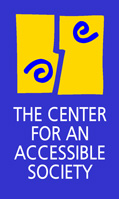
DISABILITY
ISSUES
INFORMATION
FOR
JOURNALISTS
ABOUT
THE CENTER
Even "accessible" websites remain difficult for people with disabilities, says study
Note to readers: links to news articles may not work after a few weeks, as news media remove current stories to their archives. The link may take you to the archives section, where, for a fee, you can view the article.
Oct. 23, 2001 -- A new study has confirmed what accessibility experts continue to point out: the Worldwide Web remains pretty un-usable for anyone who cannot see a conventional computer screen and use a mouse with dexterity.
"Web usability is three to six times better for non-disabled people than for people with low vision, no vision or motor impairment," says Jakob Nielsen, who the New York Times calls "the guru of web page usability." His firm, the Nielsen Normal group, recently released a study that shows this pretty conclusively.
Their 104 subjects included users with low vision, no vision, or motor impairment and a control group of people without disabilities, who were assigned 4 tasks: Find the average temperature in Dallas in January; buy Janet Jackson's CD "All for You" from Target's website; find a bus departing O'Hare airport to a specific address in Chicago using the Chicago Transit Authority website, and find the best mutual fund satisfying certain criteria on Schwab's website. The control group of people without disabilities were able to complete the 4 tasks 78% of the time; screen reader users only 12.5% of the time. While the control group spent only a little over 7 minutes "on task," the others took over twice as long. The control group's error rate was only .06; screen reader users' error rate was 2.0; screen magnifier users', 4.5.
"Beyond ALT Text: Making the Web Easy to Use for Users with Disabilities" was released last week at the Nielsen Norman Group's Usability conference in Washington, DC. An overview of the 148-page report is online at http://www.nngroup.com/reports/accessibility -- there's a link there for downloading the report ($190). "Bad design kills Websites," runs the headline of Washington Post internet columnist Leslie Walker's Oct. 25 story about Nielsen's conference (online at http://www.washingtonpost.com/wp-dyn/washtech/techthursday/columns/dotcom/A48167-2001Oct24.html).
Walker's column refers to economics; but Chapman University's Art Blaser says discussions based only on economic reasons to provide access miss the point. "When we pass legislation ensuring rights, we make a statement: those rights are too important to be guaranteed only when they're cost-effective." Chapman says most "distance learning" courses today remain inaccessible as well, despite software that provides access if used correctly. Read Blaser's article online at http://www.raggededgemagazine.com/0901/0901ft1.htm
Read more about the legal requirements for web access at http://www.accessiblesociety.org/topics/webaccess/sect508.htm.
For the Center's overview of web access issues, visit http://www.accessiblesociety.org/topics/webaccess/index.htm
Visit Jakob Nielsen's website at http://www.nngroup.com/